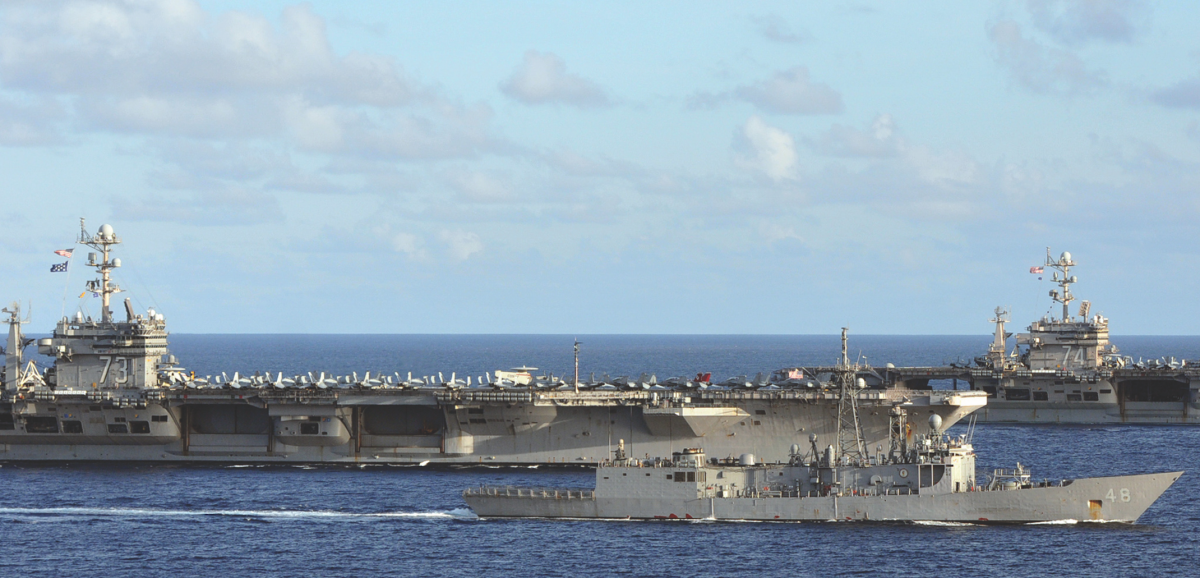The U.S. Navy recently released a request for proposals for design of a new guided-missile frigate, labeled the FFG(X). It follows the contentious littoral combat ship (LCS) program in an effort to provide the fleet with a low cost, multimission, small surface combatant similar to the Navy’s LCS predecessor, the Oliver Hazard Perry (FFG-7)–class FFG. The FFG(X)—“X” indicates that the design has not yet been determined—is meant to address the issues that have plagued the LCS and assume the role of a multimission frigate. In 2015, the last of the Oliver Hazard Perry frigates were decommissioned because the class was aging and unable to take on the latest systems without extensive investment costs. The proposed frigate is on the right track, assuming the course can be kept.
In an attempt to develop a class of ship that could adapt to a new world of cutting-edge warfare and technological advancements, the Navy directed two variants of LCS to be built. When the USS Freedom (LCS-1) was launched in 2006, there was great promise for the Navy’s small surface combatant fleet. Ships were built to be modular and capable of taking on missions commensurate with the perceived threat; moreover, they were built to change out mission modules within 96 hours. If a ship was configured for surface warfare (ship-on-ship engagements), it could ostensibly pull into port and change to an antisubmarine-warfare or mine-countermeasures-configured ship within four days. Unfortunately, the modules were far from ready to support deployment of these ships upon commissioning. In 2008, the USS Independence (LCS-2) was launched—this futuristic-looking, aluminum trimaran—was the impressive first “2nd variant” in the LCS class.
The two variants were compared and assessed for capabilities, with the best to be chosen and 52 to be built. The Navy never did choose only one variant. Now the Navy has committed to building only 16 of each variant. These are two different ships, two different engineering plants, different weapon systems, and two different sets of training problems (individual and unit training). In addition to the costs involved in two different variants of the LCS, there are also the costs associated with adapting mission modules—and training the associated detachments of sailors—to each variant.
Both variants are impressive, capable, and manned with some of the best-trained sailors in the Navy. As more of the shipbuilding and systems have been contracted to private companies who use proprietary systems, however, the Navy has lost sight of one of the most important attributes of the Oliver Hazard Perry class: the unparalleled self-sufficiency of the crews. Sailors repaired and maintained their equipment in an age of declining budgets where new missions and requirements took necessary funding away from the low-mix vessels. There was little redundancy on the FFG: one screw, one shaft, two gas turbine engines, one gun, one air search radar, etc. A self-sustaining mantra was essential for FFG sailors. This mantra was lost on the LCS because of the reliance on contractors and proprietary troubleshooting. Unlike on the LCS, frigate sailors could repair almost anything on board without outside assistance. The Oliver Hazard Perry sailors took pride in their ability to keep their ships operational and ready in the face of dwindling funding, manpower, and parts support.
LCS sailors do not have the time, the parts support, or the onboard capability to repair all systems. While they are well trained in the operation of the ship, they do not have the in-depth training or the manpower to delve deeply into a diesel engine or to disassemble all components of a weapon system and bring it back to life. The majority of equipment casualties that occurred onboard my LCS forced us to rely on outside contractor support and have parts shipped in, rather than pulled from the limited onboard storeroom. This reliance is not practical if a crew finds itself in a combat environment or operating in restricted waters.
The recent increase in the defense budget affords an opportunity to build a warship that can meet the myriad of challenges of the global arena. Whatever the final iteration of the FFG(X), it must have four attributes:
• First, it must have a fully manned crew capable of conducting the range of preventative maintenance or repairs. The Navy must cut back on proprietary systems that force reliance on contractors.
• Second, the design-and-build plan must be adhered to throughout the process—no more changing designs to adapt to untested future considerations that delay construction and cost billions of dollars in wasted expenses.
•Third, the Navy needs to commit the resources to make sure the ship is functional and mission ready when commissioned.
• Fourth, the ship needs to be able to steam with a carrier strike group without excessive refueling requirements. The Freedom variant needs to refuel almost daily traveling at speeds above 13 knots because of its high fuel burn rates and small fuel capacity (125,000 gallons).
The FFG(X) program has the potential to meld technology, speed, agility, endurance, and weaponry with the proven can-do strength of FFG sailors. Although I believe in the future of the LCS, the Navy must not repeat past mistakes, such as design vacillations, poorly functioning mission modules, unclear manning policies, and overreliance on contractors. A commitment to building the FFG(X) will require a better hull, mechanical and electrical designs, proven mission systems, clear contracts with measurable milestones, adherence to deadlines, and a long-term sustainment plan—all issues that have plagued the LCS program.



